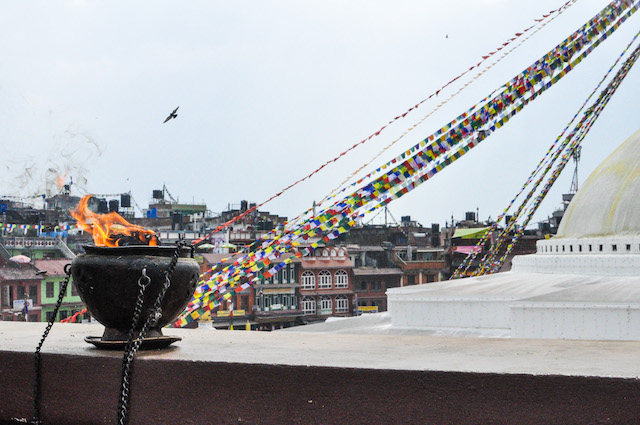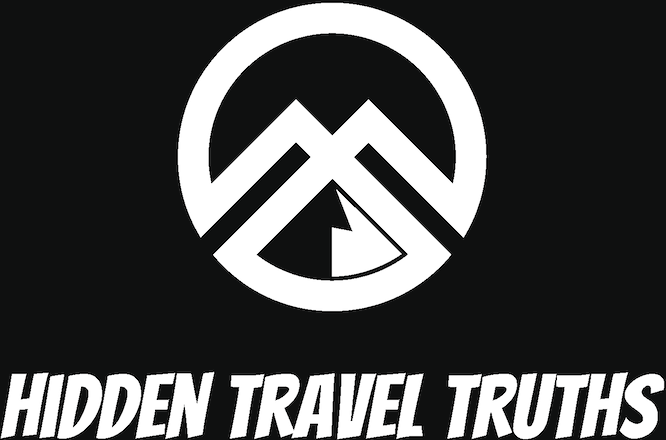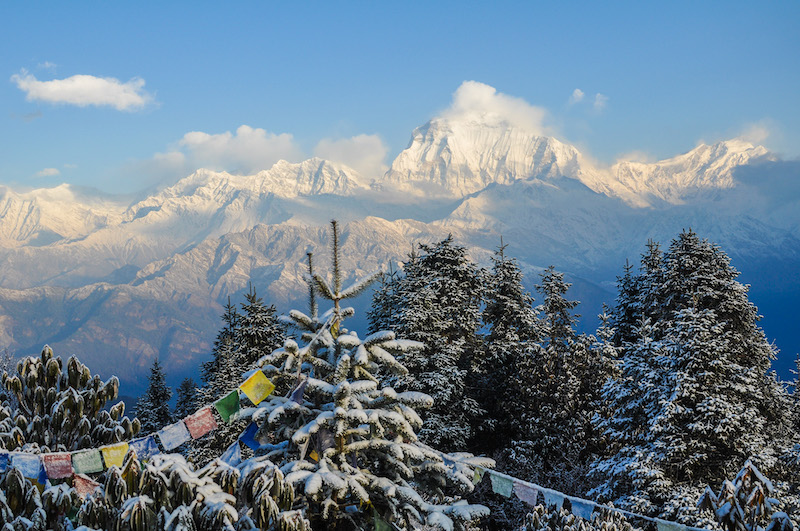Hard Truths:
- Kathmandu shows itself as a 3rd world city with very polluted streets and air
- Nepali ‘Flat Hikes ‘ are really not flat at all
- On hikes you might not see the Peak if the weather isn’t cooperating
Not every Tea House has hot water so prepare for cold showers or pack lots of wet wipes!
- Flights to see Everest can be very temperamental, don’t count on them taking off
- The Himalayas are so tall Everest can get lost in the mountain view skyline
Can’t Miss:
- Temples of Kathmandu
- Tibetan Prayer Flags & Monks
- Hiking, hiking and more hiking

I was lucky to get to Nepal just before the big earthquake in 2015. Literally just before, I was there for Chinese New Year in February and the earthquake hit in April. It was a devastating destroying a lot of the city including damaging four out of seven Unesco World Heritage sites in the Kathmandu valley, Kathmandu Durbar Square, Bhaktapur Durbar Square, Patan Durbar Square and the Changunarayan Temple. So, I’m sorry if my pictures don’t represent the Kathmandu of today.
Kathmandu is a very polluted city. It looked like the city was encompassed in a sandstorm. A lot of it is due to uncontrolled vehicle emissions, smoke emitted from brick kilns, dust from ongoing infrastructure projects. But amidst the brown haze bright orange shades glow. Men and women are clad in the colors as these colors represent fire which can burn impurities allowing them to be purified.
Kathmandu is also known as the city of temples because of its many ancient pagodas and stupas. You will easily stumble upon them especially surrounding Kathmandu Durbar Square.
While visiting the many temples and squares you’ll notice the colorful powders adorning all of the statues of the gods and goddesses.
The powder, know as gulal, expresses sincere blessings and good wishes. Each color symbolizes something differed. Red is associated divinity, prosperity love, commitment, strength and bravery. Blue is associated with the divine, green is associated with new beginnings and prosperity, and saffron is purity, wisdom, and the quest for light.
All the squares and temples can be confusing as they look so similar. I had to go back and google which were which from my pictures. This one is Swayambhunath. According to Wikipedia, the Tibetan name means ‘Sublime Trees’ for all of the different varieties of trees found on the hill. It is also known as ‘The Monkey Temple’ and lives true to it’s name with monkeys wandering around.
The city is a bit spread out so it’s best to hire a guide to take you to some of the sights in the outskirts such as Boudhanath. Also known as Boudha, it is located 7 km northeast Kathmandu. and home to one of the largest Buddhist stupas in the world, built during the 5th century AD. It is an important place of pilgrimage and meditation for Tibetan Buddhists and local Nepalis.
You’ll always notice candles and incense burning amongst the temples and stupas. They are a mark of respect or deference and are used to evoke the state of impermanence and change; a cornerstone of the Buddhist philosophy. The light from a humble candle is also said to symbolise the enlightenment of the Buddha.
Bhaktapur 20 km east, pedestrian city, World Heritage Site, best preserved, largest of 3 royal cities
Narrow cobblestone streets wind between the red-brick houses, joining a series of squares and courtyards that are peppered with temples, statues, cisterns and wells.
From Kathmandu, most trekking companies will take you to the various areas to begin your adventure. A big trekking basecamp is Pokhara which is a 6-7 hour drive away. It’s a quaint town on Phewa Lake. It’s known as the gateway to the Annapurna Circuit. The lakeside cafes have a nice chill vibe and are a very welcome change post trek.
My trip was one of the shorter options, Ghorepani Poon Hill trek (sometimes also known as the Annapurna Panorama Circuit) booked with Mountain Monarch. They say this is one of the low-elevation treks into the foothills of the Annapurna region.
The start was in a town called Nayapul.
Small groups will only have 2 main guides. One to lead the trek and one to follow behind.
The trek began with 6-7 hours to Ghandruk, the biggest Gurung rural community in the region. This is where I learned what the ‘Nepali flat’ really meant. Every part of the trek was pretty much hilly. On these guided treks, all you need to carry is your daypack. Donkeys follow all the groups strapped with everyone’s gear.
Along the way there are sparse villages that look to be perched on the mountainside.
All the stops were at teahouses dotted throughout the trails. This is where you stop for lunches and overnight stays. The mountains started to appear behind one of them. Annapurna South, Hiunchuli, and Machchapurchare mountains were the backdrop.
It was quite impressive to walk amongst the massive rhododendron trees. I’ve only ever seen these as bushes so can just imagine how beautiful the forest would be in full bloom. The next stop was Tadapani (2,630m / 8,628ft) . We hike through the beautiful forest of Rhododendrons, Maple, Oak, and many other floras.
Day 6:Hike to Ghorepani: (2,860m/9,383ft)

